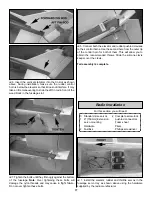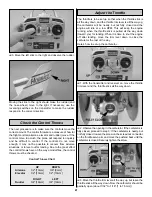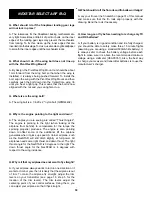
✔
After flying for the day, use your fuel pump to drain
excess fuel from the tank.
✔
After each day's flying, use spray cleaner and paper
towels to thoroughly clean the model. After a complete
flight there will be a fair amount of exhaust oil residue
sprayed on your fuselage. Do not be concerned with this.
It is normal. The oil used in model engines does not
completely burn with combustion.
✔
The Hobbico NexSTAR ARF is factory-covered with iron-
on model covering film. Should repairs ever be required,
the covering can be patched with new pieces of iron-on
covering. Among several types of covering that will work,
Top Flite MonoKote film may be used to make repair
patches to this model. MonoKote is packaged in six-foot
rolls, but some hobby shops also sell it by the foot. If only
a small piece of covering is needed for a minor patch,
perhaps a fellow modeler would give you some. The
covering is applied with a model airplane covering iron,
but in an emergency a regular iron set to a lower
temperature could be used.
✔
Check all screws that hold the wings together, tail bolts,
engine bolts, wheel collars, etc.
✔
Check all the high-stress areas for cracks or fatigue such
as the landing gear area, the wing mounting area, stab
and fin mounting area. Before storing the model until the
next fly day, wrap some paper towels around the engine.
Some oil may accumulate and drip off of the engine and
muffler while the airplane is stored.
After you feel comfortable flying the Hobbico NexSTAR ARF
and you want to improve its high speed performance, the
first thing you can do is to remove the SpeedBrakes Training
Flaps. Remove the six screws that hold them in place. The
NexSTAR ARF was optimized to fly with the flaps on, so if
you remove them, you will have to retrim the elevator.
Without flaps, the NexSTAR ARF will try to pitch down (nose
down) until you re-trim it. Without the SpeedBrakes Training
Flaps, the airplane will fly much faster at any throttle setting
and longer landing approaches will be needed. Also, the
NexSTAR ARF will not slow down as quickly when the nose
is pointed down and stall speed will increase slightly.
The second thing you can do to improve the high speed and
aerobatic performance of the Hobbico NexSTAR ARF is to
remove the SpinControl Airfoil Extensions. These extensions at
the leading edge of the wings are held in place with tape that
can be carefully removed. Once you remove these extensions,
you will need to re-trim your elevator to align it with the
stabilizer. The SpinControl Airfoil Extensions produce the
opposite effect of the SpeedBrakes Training Flaps in pitch,
so if you remove both, the net pitch effect would be almost
non existent. After you remove these extensions, the
NexSTAR ARF will be faster and able to spin and snap. Also,
the stall speed will increase slightly.
Dual Aileron Servos.
The Hobbico NexSTAR ARF comes equipped with dual aileron
servo trays for dual aileron servos. If you wish to use flaperons
you will need to upgrade your radio system to 6 channels. To
install the dual aileron servos, use the following instructions.
For this section you will need:
1 Additional aileron
servo (same type as
that already installed
in your NexStar)
1 “Y” harness
2 2 mm Pushrods
2 Nylon clevises
2 Clevis retainers
2 Faslinks
1 Servo mounting
hardware set
1 Screwdriver
1 Wire cutter
1 Pliers
1 Thin CA
Dual Aileron Servos
SpinControl Airfoil Extensions
SpeedBrakes Training Flaps
AFTER YOU MASTER THE NEXSTAR
ARF IN ITS ORIGINAL FORM
Clean Up
MAINTENANCE TIPS
27
Summary of Contents for NexStar ARF
Page 31: ...31 Correct Angle Rods Fin...
Page 32: ...32...




















